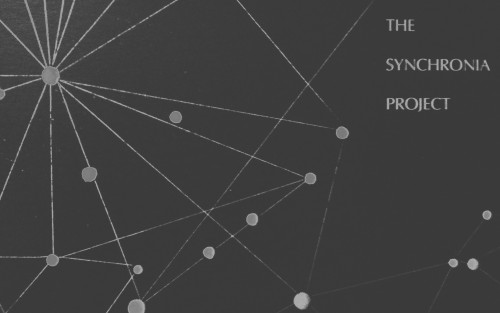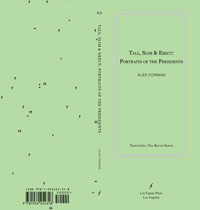Interview: The Synchronia Project
The Synchronia Project, slated for release next February, is difficult to define. Not exactly a journal, it is a composite, open-ended literary endeavor that will feature work by multiple authors. But it is not a collaboration between the authors; the only collaboration happening is between editors Emily Kiernan and Joe Trinkle , who will be reading the submissions and arranging them into a larger whole. The end goal remains vague, only because the project is still accepting submissions. It is these submissions that will in large part determine Synchronia’s direction, and Kiernan and Trinkle hope to discover a larger narrative—a feeling of synchronicity—across the selected pieces. I had the opportunity to interview these two and learn more about the project.

***
Dan Hoffman: What was the impetus behind The Synchronia Project? Was there a specific literary influence, or did it evolve from a bigger reading of the collective writing you see as editors and writers?
Joe Trinkle: I think it started by us wanting to create something from other people’s work. We’re both writers who read a fair amount of anthologies and literary journals, and we wanted to do something ambitious, something more than just a collection of stories that we like. I think, somewhere in the back of my head, when I’m reading several simultaneously produced journals, online or in print, I notice how much we are writing about the same things or writing in similar voices, and we wanted to play around with that. To see if a pool of submissions would reflect some kind of pattern.
In a larger sense, some of my favorite novels feel like several broken novellas woven together, stories that would not have had nearly as much effect on a reader by themselves, but somehow add to each other, compliment, enhance each other, even if their plots don’t cross paths. I’m thinking Last Exit to Brooklyn, Infinite Jest, and some of the great short story collections of the twentieth century—those kind of books. I actually just read Cloud Atlas, which is a perfect example of what I was thinking about when Emily and I first discussed this project. I wanted to see what it would be like to try to create a fractured novel like that, but with stories from several writers.
Emily Kiernan: It absolutely had a lot to do with the kind of work we like to read. Fracture has been one of the watchwords of literature since the advent of modernism, and. we grew up as readers and writers in a world where that kind of fallen-apart messiness was a dominant form. Most of our models for what it meant to write about the present world, or for what it meant to approximate our experience, inhabited that kind of cut-up space. So of course we are drawn to these broken narratives. One of the first books I remember Joe and I bonding over was Winesburg, Ohio, which had that distinctly modern novel-in-stories form. It is a flat-out rejection of cohesion. Given this history, I think it is natural that we wanted to extend that form outwards, from the book itself to the magazine or the collection.
One thing that I think is remarkable about The Synchronia Project, though–which actually works against this tradition–is that we’re not fracturing something whole, but rather trying to fit these broken pieces together. Binding up the wounds (a little fragment of language that knocks about in my head).
DH: It seems to me that the closest antecedent to The Synchronia Project actually belongs to the realm of cinema, and not of literature, because even if a single literary text unifies multiple narratives it is still, finally, only written by one author; whereas arguably in cinema there is often no single “author” of the film. How much, if at all, was cinema an inspiration for this project?
JT: I watch an embarrassingly low number of films, so my immediate response would be not much. But I’d argue that even though a book usually has only one author, it often times has many editors; it often goes through the finely cut die of a workshop or an MFA program, and the ideas that are infused into the text partly come from reading the work of others. The idea of “one author” is true, but there are a lot of hands on the text, both directly and indirectly.
EK: I also can’t claim any substantial film knowledge, beyond having watched a few more of them than Joe, so any cinema influence on the project would be indirect. As for the one-author element, there actually is a lot of collaborative writing out there, though I suppose it’s more common in poetry than in fiction. (Can I advertise? I’d like to advertise. A few good friends of mine recently started Bon Aire Projects, which publishes exclusively collaborative work.) Jack Kerouac and William S. Burroughs wrote a novel together called And the Hippos Were Boiled in Their Tanks. Supposedly the name came from a news report about a fire at a circus—a fact that haunts me. The poor hippos.
DH: On that note, is there any connection between your ideas on authorship (post-Barthes, post-deconstructionism, etc. etc.) and the spirit of The Synchronia Project? Because it seems to me that such an endeavor must in part emerge from a distinctly contemporary conception of what it means to read and interpret texts. Would you say that, in a sense, this is as much about your interpretation of the submissions as their intrinsic qualities?
EK: I don’t think we are out to make any particular comment on authorship–there still exists more than one valid way to own or not own your work–though I suppose we are exploring one of the little rooms that Barthes et al opened up. We’re mostly a bit over-enthusiastic and a bit over-confident and want really badly to be in on the good stuff we see happening all around us in the writing world, so we manufactured this bribe of publication to get our favorite writers to let us futz with their work. We are, in a sense, asking our favorite authors to put aside their authorship for the duration of this project, to engage in this particular book/journal/what-have-you on different terms. It’s a playful thing at heart, and I want authors to engage in it in that way.
It is also strange and intimate what happens when you ask people to work with you, to be in your circle, in this odd way, and we are interested in that act of unearned generosity or faith. There are always problems with gate-keeping, with editing, with privileging one voice over another, and this project puts pressures on those seams in a way that I hope will be revealing, and that I hope will work.
JT: I listen to/watch many author interviews, and something I’ve noticed is how surprised writers can be by the things that others find in their work. Writing fiction is largely intuitive, I think, as well as the revision process, and while major motifs are often intentional, other aspects of the work just kind of sneak in from the subconscious, or the part of the brain that thinks abstractly, that doesn’t quite focus on words. So when a great book is written, and everybody reads it and then someone sits the author down for an interview, they ask her all of these questions, to which she ends up replying, “Yeah, that just kind of happened,” or “Sure, I can see that.”
In this way, themes seem to emerge that the author is not entirely in control over, and when you look at several works from within a given time period, it’s even easier to draw lines between those unconscious themes. To answer your question: we want to see work that is good, to identify those unintentional unifying themes, and to thread it together with other work with similar sub- or unconscious trajectories.
November 20th, 2013 / 12:00 pm
Tall, Slim and Erect: Portraits of the Presidents
 Tall, Slim & Erect: Portraits of the Presidents
Tall, Slim & Erect: Portraits of the Presidents
by Alex Forman
Les Figues Press, 2012
131 pages / $15 Buy from Les Figues Press
James Monroe was the third president to die on the fourth of July. Franklin Pierce was arrested for running a woman over with his horse. James Buchanan carried his head cocked to the side like a poll parrot (whatever that is). These and other trivial-pursuit answers are drawn from Tall, Slim & Erect: Portraits of the Presidents, Alex Forman’s compelling and often very funny book of short presidential biographies. With text appropriated from dozens of sources, Forman presents us with a surprisingly dishy view of our first thirty-seven leaders that, through her light touch, still manages to bring up some highly relevant questions about our expectations of history and our chaotic construction of public figures.
In his introduction to the text, Ben Ehrenreich characterized Forman’s effort as one to humanize the presidents, and the portraits are, indeed, deeply human, with a heavy emphasis on personal foibles and physical oddities. The Presidential body is essential to these portraits. Of course we might claim that the presidential body is essential to a great deal of political discourse—from Obama’s smoking and Cheney’s beat-less heart to that final dictatorial accessory, the glass coffin—but what Forman gives us is something different, not the body as symbol or the body as tool of power, but the body as body. Grant “had unusually small hands and feet,” Coolidge was “deficient in red corpuscles,” and while Washington’s famed wooden teeth don’t make an appearance, his pockmarks and bouts of dysentery do. The bodies depicted here are intimate bodies, embarrassingly physical, and not fit for public perusal—which makes it especially striking that this book is, in large part, a compilation of public perusals. Drawn from a few centuries worth of news, diaries, histories, speculations, Wikipedia articles, and gossip, Tall, Slim, & Erect is a distillation of the public gaze.
April 27th, 2012 / 12:00 pm
